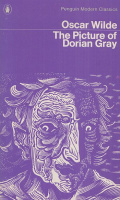kategóriák
- Közlekedés ajánlójegyzék
- Szocreál ajánlójegyzék
- Reklám ajánlójegyzék
- Fotó ajánlójegyzék
- Kínai-japán ajánlójegyzék
- Szentkép ajánlójegyzék
Új árakkal! - Új szentkép ajánlójegyzék II.
- 12 érdekes régiség
 Könyv
Könyv
 Bibliofilia
Bibliofilia
 Régiség
Régiség
 Metszet
Metszet
 Térkép
Térkép
 Fotó
Fotó
 Papírrégiség, Aprónyomtatvány
Papírrégiség, Aprónyomtatvány
 Plakát
Plakát
- Cirkusz
- Modern grafika
- Szocreál
- NER Irodalom
- Egyéb
kosár
üres a kosár
nincs bejelentkezve
Wilde, Oscar : The Picture of Dorian Gray
- leírás
- további adatok
Series: Penguin Modern Classics.
The Picture of Dorian Gray was Oscar Wilde's only novel (he's mostly famous for his plays, poetry, and short stories), but what a novel it is! In the century or so since its initial publication in 1890, the fate of poor Dorian Gray has taken hold of the popular imagination. Dorian's story plays upon the timeless theme of selling one's soul in exchange for earthly pleasures (see other classics like Goethe's Faust or the musical Damn Yankees), and the inevitable disaster that results. Wilde's version of this narrative is particularly notable for its embrace of the hedonistic lifestyle of the Decadents, a late nineteenth century artistic movement that prized beauty and aesthetic experience over everything else. Dorian Gray and its protagonist have become synonymous with the pursuit of pleasure, regardless of its moral consequences.
The novel raised quite a blizzard of scandal in its day, and had critics denouncing Wilde for what they perceived to be his own innate immorality – and as a result, he responded with the famous "Preface" to the novel (published in its second edition) that explained his artistic beliefs. (Check out more discussion of the Preface in "What's Up with the Epigraph?") Altogether, The Picture of Dorian Gray reveals Wilde's philosophy more than any of his other works; reading it is an essential key to understanding his artistic mission as a whole.
The Picture of Dorian Gray was Oscar Wilde's only novel (he's mostly famous for his plays, poetry, and short stories), but what a novel it is! In the century or so since its initial publication in 1890, the fate of poor Dorian Gray has taken hold of the popular imagination. Dorian's story plays upon the timeless theme of selling one's soul in exchange for earthly pleasures (see other classics like Goethe's Faust or the musical Damn Yankees), and the inevitable disaster that results. Wilde's version of this narrative is particularly notable for its embrace of the hedonistic lifestyle of the Decadents, a late nineteenth century artistic movement that prized beauty and aesthetic experience over everything else. Dorian Gray and its protagonist have become synonymous with the pursuit of pleasure, regardless of its moral consequences.
The novel raised quite a blizzard of scandal in its day, and had critics denouncing Wilde for what they perceived to be his own innate immorality – and as a result, he responded with the famous "Preface" to the novel (published in its second edition) that explained his artistic beliefs. (Check out more discussion of the Preface in "What's Up with the Epigraph?") Altogether, The Picture of Dorian Gray reveals Wilde's philosophy more than any of his other works; reading it is an essential key to understanding his artistic mission as a whole.
| állapot: |      |
| kategória: | Könyv > Idegennyelvű könyvek > Angol nyelvű > |
| kiadó: | Penguin Books, (1969) |
| cikkszám / ISBN: | 0027767 |
| kötés: | fűzve |
| oldalszám: | 247 |
| könyv nyelve: | angol |



























































 Telefon:
Telefon: E-mail:
E-mail:







